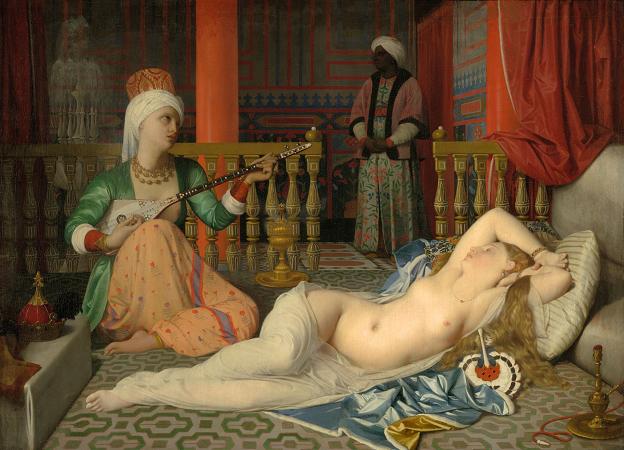
Odalisque with Slave. Ingres painted a number of harem scenes during his long career, starting with the Grande Odalisque.
These works exemplify a taste for Orientalist subject matter shared by many French painters of the Romantic era, notably Ingres' rival Eugène Delacroix. As Ingres never visited the Near East, Odalisque with Slave depicts an imaginary scene.
It was composed in Rome, where the artist lived from 1835 to 1841 while serving as director of the French Academy there. The odalisque was painted from a life drawing Ingres had made years earlier.
The musician was painted from a model posed in the studio, and many details such as the tanbour were derived from engravings. Ingres labored over the execution with his usual great care, and enlisted some of his students as assistants.
One of them was Raymond Balze, who wrote of his experience: Ingres began his studies from nature and prepared the rough sketch on his canvas, then had made by his students the less important parts, very finished, such as the architecture, mosaics, rugs, furniture, instruments, which he often had reposition, reluctantly satisfied with their execution. Then everything being finished with the figures, he alone undertook to harmonize the ensemble with onion skins of color. In September 1840 the painting was delivered to Paris, where it won praise from critics who viewed it in the owner's home. When exhibited publicly in 1
These works exemplify a taste for Orientalist subject matter shared by many French painters of the Romantic era, notably Ingres' rival Eugène Delacroix. As Ingres never visited the Near East, Odalisque with Slave depicts an imaginary scene.
It was composed in Rome, where the artist lived from 1835 to 1841 while serving as director of the French Academy there. The odalisque was painted from a life drawing Ingres had made years earlier.
The musician was painted from a model posed in the studio, and many details such as the tanbour were derived from engravings. Ingres labored over the execution with his usual great care, and enlisted some of his students as assistants.
One of them was Raymond Balze, who wrote of his experience: Ingres began his studies from nature and prepared the rough sketch on his canvas, then had made by his students the less important parts, very finished, such as the architecture, mosaics, rugs, furniture, instruments, which he often had reposition, reluctantly satisfied with their execution. Then everything being finished with the figures, he alone undertook to harmonize the ensemble with onion skins of color. In September 1840 the painting was delivered to Paris, where it won praise from critics who viewed it in the owner's home. When exhibited publicly in 1
Wikipedia ...